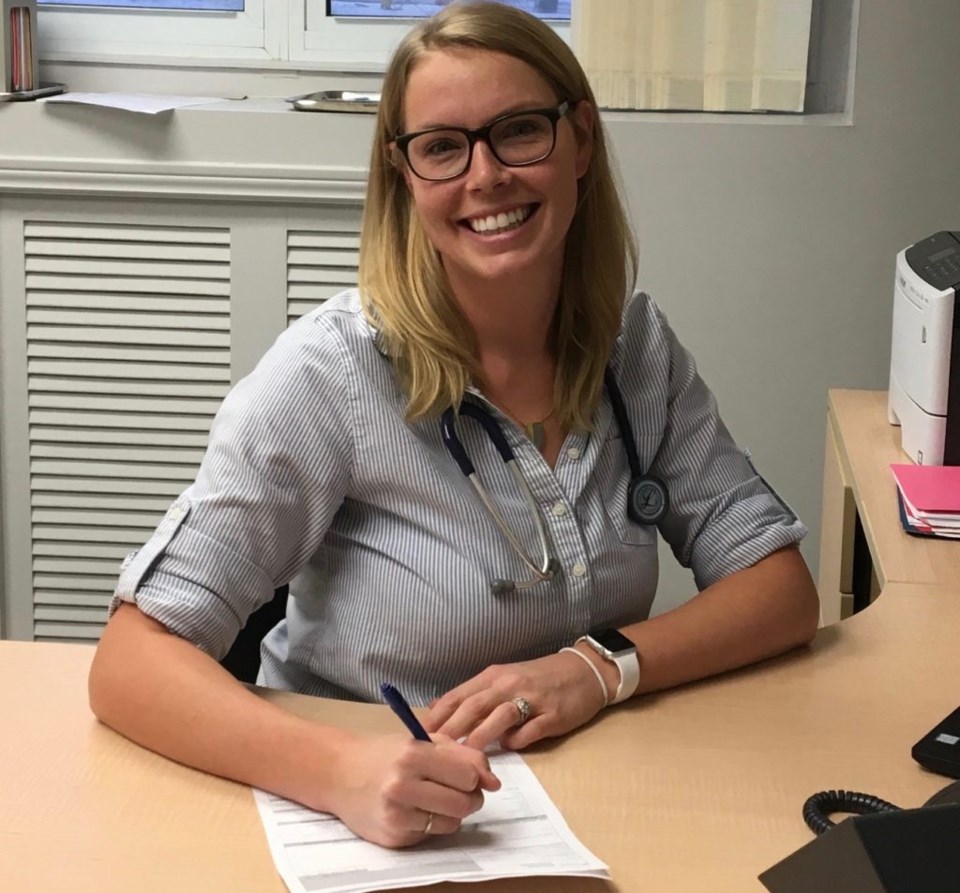
Lindsey Parr is back, her shingle hanging to declare the walk-in clinic in the Old Town is open for business.
Parr is the nurse practitioner who staffed the office in the basement of the former hospital on Wellington Street for a few short months in 2017. She took the job in July of that year, and when she began her maternity leave six months later, the office closed.
It re-opened earlier this month, Parr running it single-handedly, without so much as a receptionist to record patients’ information as they arrive.
It’s a simple take-a-number, take-a-seat in the corridor situation, and when Parr ushers the patient next in line into her office, she takes down the necessary details and registers them in through the St. Catharines office of Niagara Health, her employer. Hers is a small office, and it wouldn’t be feasible to have two people looking after it.
Parr is there to attend to patients who either don’t have a family doctor, or who need attention and can’t get in to see a doctor, she says.
She is a registered nurse who has both a master’s degree in nursing, a new requirement for the job of nurse practitioner, and supplementary education certificate.
With those additional credentials, she is authorized to diagnose, order and interpret diagnostic tests, as well as prescribe medication and other treatment.
Parr became a registered nurse already knowing she wanted to take the extra steps needed to become a nurse practitioner, she says. “I was interested in expanding my knowledge and scope of practice, and enjoy having the ability to practice autonomously.”
The walk-in clinic is an office distinct from the local family health team and the doctors who share space at the former hospital, says Parr, but they work in collaboration when needed. If she feels she would like a doctor’s advice, she has only to walk down the corridor to get it.
“If I want to consult with a doctor, I can. We’re separate entities who can work together. Our funding comes from different sources, but we work as a team.”
She will see as many people as possible in a day’s work, she says, without appointments. “However my hours are subject to capacity and if volumes are high I may not be able to accommodate everyone.”
To clarify when it’s appropriate to seek care from a nurse practitioner, Parr explains: “I would say the medical concerns I can assist patients with would include those of less urgency, that have potential for complications or are causing mild distress, and in which the patient would benefit from intervention or medical advice.”
That would include minor injuries, including lacerations — she can provide sutures and wound assessment — minor infections such as urinary tract, throat, sinus or ear problems, which are the symptoms of the majority of people she sees — or minor abdominal pains and rashes.
She is also able to assist patients with “episodic primary care issues,” including refilling some prescriptions.
The scope of a nurse practitioner, she says, which has come to include writing prescriptions for most drugs, has become much broader in recent years.
When patients choose to see a nurse practitioner instead of a doctor, it can help ease the burden of doctor shortages. Nurse practitioners are sometimes more readily accessible and can often spend more time with a patient than a busy doctor with a tight schedule of people to see — that’s a comment Parr often hears from her patients, she says.
As hard as it was for her to leave her baby, a little boy, and return to work, she loves her job in Niagara-on-the-Lake.
She heads along the highway from her Port Colborne home every morning, looking forward to the people she will meet during the day.
When she began working for the clinic, she was taking over from nurse practitioner Joan Ostrander, who had staffed the office for 15 years and developed a strong rapport with regular patients. As the newer kid on the block, Parr she isn’t quite there yet, although she is starting to get to know people.
“I”m happy to be here. This community is awesome. Everybody here is great.”
Sean Simpson of Simpson’s Pharmasave says for some locals, the walk-in clinic is the only option in town.
“It provides a great service for residents who don’t have a family doctor,” he said.
“I’ve already seen patients who are utilizing it, and they’re happy it’s open. It’s a great complement to the other medical services in town,” said Simpson. “We’re very pleased to find the service open and running.”
To access the walk-in clinic, Parr says, use the back door of the hospital that is reached from the parking lot. Go downstairs — it’s actually the basement but labelled as the ground floor — and there will be a sign pointing down the hall.
The hours of the clinic, at 176 Wellington Street, are Monday to Friday, 9 a.m. to noon, and 1 p.m. to 3:30 p.m.